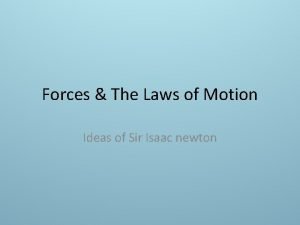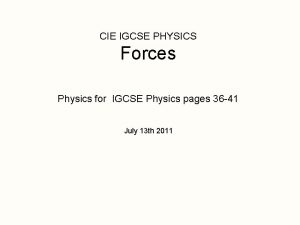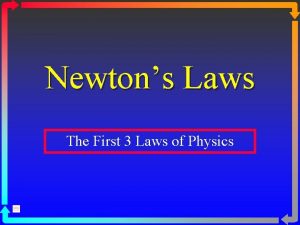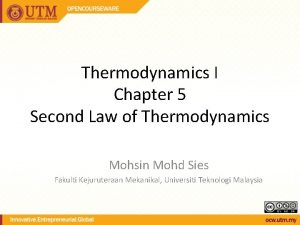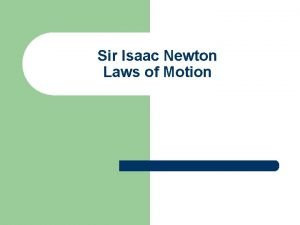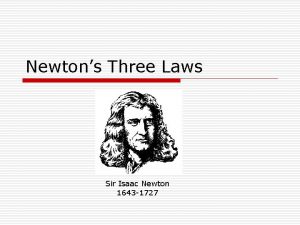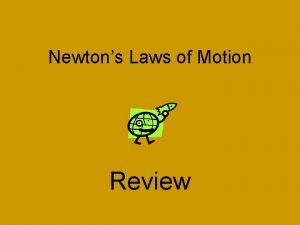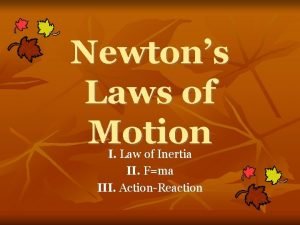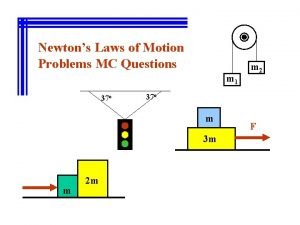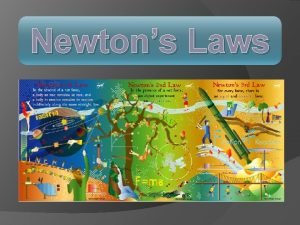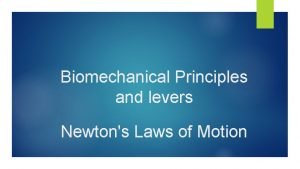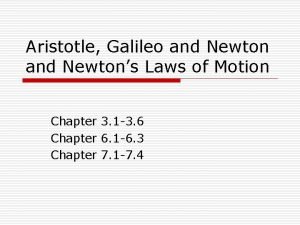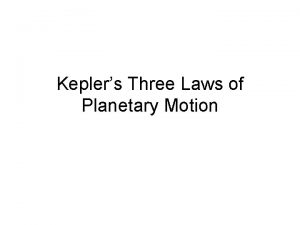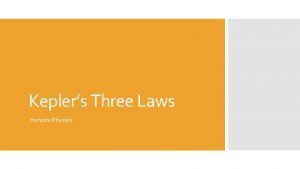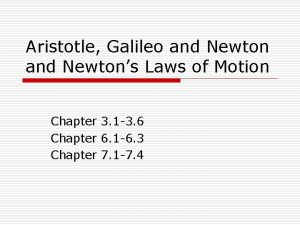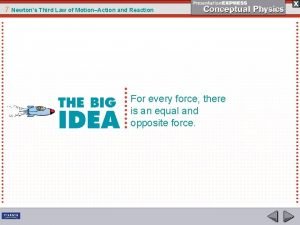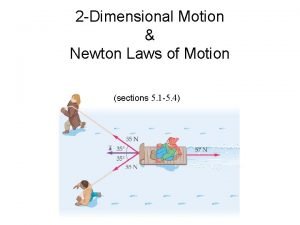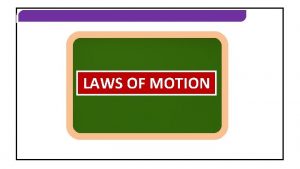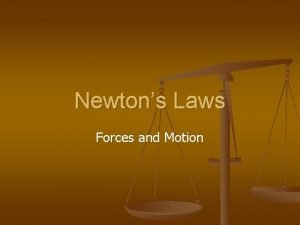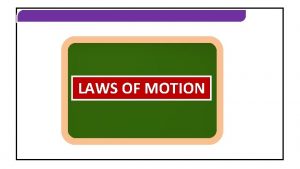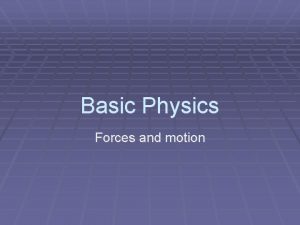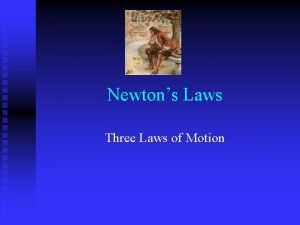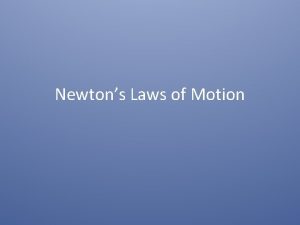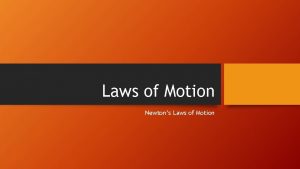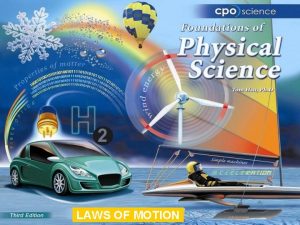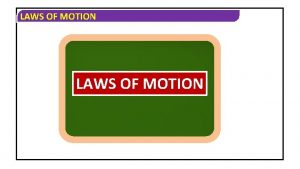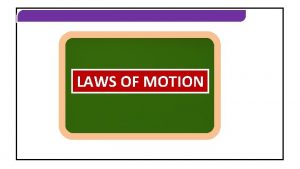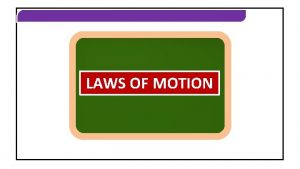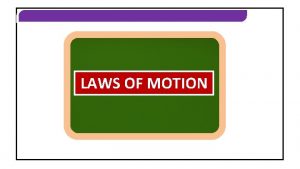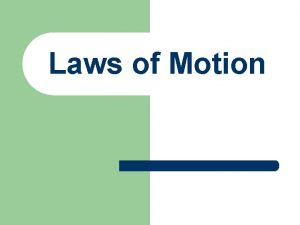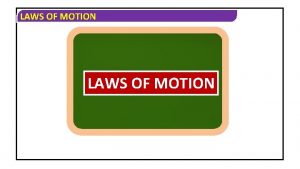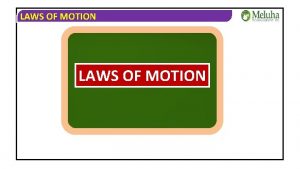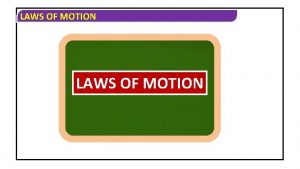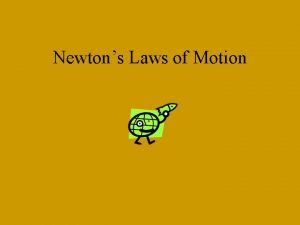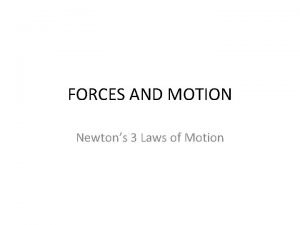Forces Laws of Motion Ch 4 Physics Forces




























- Slides: 28

Forces & Laws of Motion Ch 4 Physics

Forces & the Laws of Motion p Objectives n Describe how force affects the motion of an object. n Interpret and construct free body diagrams p Dynamics investigates the cause of an objects motion. p Force is an influence on an object that causes the object to accelerate. (Example pushing or pulling) n Unit – Newtons (N) – 1 N Force causes a 1 Kg object to accelerate to 1 m/s 2

Forces & the Laws of Motion p A Force is an action exerted on an object which may change the object’s state of rest or motion. n Causes object to start or stop moving or change direction p Forces can cause accelerations p 2 types of forces n Contact forces – physical contact between two objects p Ex: Frictional force, normal force, tension, spring force, air resistance n Field force – No physical contact p Ex: Gravity, magnetic force, electric force

Newton’s First Law p Newton’s First Law – Law of Inertia n An object in motion tends to stay in motion; an object at rest tends to stay at rest n An object with no net force acting on it remains at rest or moves with constant velocity p Inertia – is the resistance an object has to a change in its state of motion n The amount of inertia an object has depends on its mass p Mass is the amount of material in a body (Kg) p Weight is a measure of the gravitational force on an object (N)

Newton’s 2 nd Law p Force = mass x acceleration n An object will only accelerate if there is an unbalanced force q The acceleration of an object is directly proportional to the net force acting on the object and inversely proportional to the object’s mass. SF = ma net force = mass acceleration S F represents the vector sum of all external forces acting on the object, or the net force.

Newton’s 2 nd Law FA = 1000 kg x 0. 05 m/s/s FA = FB = 2000 kg x 0. 05 m/s/s FB =

Newton’s 3 rd Law p For every action there is and equal and opposite reaction n The astronaut pushes on the rock and the rock pushes on the astronaut

Action and Reaction Forces p Action force – force that object 1 exerts on object 2 Reaction force – force that object 2 exerts on object 1 p Doesn’t matter which is which p Action – Reaction pairs p n n n Each force acts in different objects Do not result in equilibrium Always in pairs Consider driving a nail into wood with a hammer. The force that the nail exerts on the hammer is equal and opposite to the force that the hammer exerts on the nail. But there is a net force acting on the nail, which drives the nail into the wood.

Free-body diagrams are used to show the relative magnitude and direction of all forces acting on an object.

Free Body Diagrams p Free-body diagrams – shows all the forces acting on a single object. n n p Fnet Only shows the forces acting on the object The effect of a force depends on both magnitude and direction. Thus, force is a vector quantity p Represented by arrows in appropriate direction Net Force Fnet - the combination of all the forces that act on an object.

Drawing Free –Body Diagram p Normal force FN– the force caused by 2 bodies in direct contact. n Perpendicular to the plane of contact n Normal force on a mass resting on level ground is its weight. FN = mg (mass * gravity) p Steps to draw free-body diagrams n Draw a box or simple shape of object p In same position – if on inclined plane, so should shape n Draw & label vector arrows p All arrows are drawn from center of object n Choose a coordinate axis system, one that puts the most forces on the axis's

Force Diagram Vs Free-Body Diagram Force Diagram In a force diagram, vector arrows represent all of the forces acting in a situation Free-Body Diagram A free-body diagram shows only the forces acting on the object of interest—in this case, the car.

Net Force p Newton's first law refers to the net force on an object. The net force is the vector sum of all forces acting on an object. p The net force on an object can be found by using the methods for finding resultant vectors.

Problem 1 p A book is at rest on a table top. Diagram the forces acting on the book. p In this diagram, there are normal and gravitational forces on the book.

Problem 2 A flying squirrel is gliding (no wing flaps) from a tree to the ground at constant velocity. Consider air resistance. A free body diagram for this situation looks like… Gravity pulls down on the squirrel while air resistance keeps the squirrel in the air for a while.

Problem 3 A rightward force is applied to a book in order to move it across a desk. Consider frictional forces. Neglect air resistance. Construct a free-body diagram. Note the larger applied force arrow pointing to the right since the book is accelerating to the right. Friction force opposes the direction of motion. The force due to gravity and normal forces are balanced.

Problem 4 A man drags a sled across loosely packed snow with a rightward acceleration. Draw a free-body diagram. The applied force arrow points to the right and is larger than the frictional force since the object is accelerating. Since the sled is on the ground, the normal and gravitational force are balanced.

Sample Problem - complex Determining Net Force Derek leaves his physics book on top of a drafting table that is inclined at a 35° angle. The book has a force of 22 N, the force of friction is 11 N, and the normal force is 18 N. Find the net force acting on the book. 1. Draw the free-body diagram and identify the variables. Given: Fgravity = Fg = 22 N Ffriction = Ff = 11 N Fn = 18 N Unknown: Fnet = ?

Sample problem (continued) 2. Select a coordinate system & apply it to the free-body diagram. Choose the x-axis parallel to and the y-axis perpendicular to the incline of the table, as shown in (a) p This coordinate system is the most convenient § only one force needs to be resolved into x and y components. Tip: To simplify the problem, always choose the coordinate system in which as many forces as possible lie on the xand y-axes.

Sample problem (continued) 3. Find the x and y components of all vectors. Any vectors not on the x & y axis must be broken into its x & y components p Fg must be broken up into Fgx & Fgy n n The angle of the incline was 35 o Indicate angle is also 35 o F c o s q = g , x Fgy = Fg Cos q Fgy = (22 N) Cos 35 o Fgy = 18 N Fgx = Fg Sin q = (22 N) Sin 35 o Fgx = 13 N Fgx Fg

Sample problem (continued) 4. Find the net force in both the x and y directions. n Show all the forces Diagram acting only along the x- and y-axes. For the x direction: SFx = Fgx – Ff SFx = 13 N – 11 N SFx = 2 N 5. Find the net force. For the y direction: SFy = Fn – Fgy SFy = 18 N – 18 N SFy = 0 N

Friction p Friction – is the force that opposes motion between 2 surfaces that are in contact p In free-body diagrams, the force of friction is always parallel to the surface of contact. p Force of friction (Ff) is proportional to the magnitude of the normal force (FN) n Ff is always acts in a direction to oppose motion p Depends upon § Kinds of materials § How much they are pressed together

Types of Friction 1. Object is not moving n Static friction (Fs) is a force that resists the start of sliding motion between two surfaces that are in contact and at rest n As long as object doesn’t move Fs = - Fapplied n Maximum force of Fs is Fs, max p Fs, Max – Just before movement starts p Fs, max = s FN p s = coefficient of static friction § s depends upon the two surfaces

Types of Friction (cont) 2. Object is moving n p Kinetic friction (Fk) is the force that opposes the movement of two surfaces that are in contact and are sliding over each other. p Kinetic friction is always less than the maximum static friction. p F k = k F N § k = coefficient of kinetic friction For any pair of surfaces k < s n Its harder to push an object from rest than its is to keep it in motion

Coefficients of Friction Table

Sample problem-Friction A Student attaches a rope to a 20. 0 kg box of books. He pulls with a force of 90. 0 N at an angle of 30. 0° with the horizontal. The coefficient of kinetic friction between the box and the sidewalk is 0. 500. Find the acceleration of the box. Given: m = 20. 0 kg k = 0. 500 Fapplied = 90. 0 N Angle = 30. 0° Unknown: a=?

Sample problem-Friction • Any vectors not on X & Y axis break it into its components Fay = Fa Sinq Fax = Fa Cos q Fay = (90. 0 N)Sin 30. 0º Fax = (90. 0 N)Cos 30. 0º = 45. 0 N = 77. 9 N Sum of Forces in Y-Direction Sum of Forces in X-Direction SFx = max no motion in y Fay-Fg + Fn = 0 Fax-Fk = ma Fk=Uk. Fn SFy = may Fn = Fg – Fay Sub into eqn Fax –Uk. Fn = ma Fg = Mg Fn = Mg – Fay Fn = (20. 0 kg)(9. 81 m/s 2)-45. 0 N Fn = 151 N

Sample problem-Friction Fax –Uk. Fn = max a = 0. 12 m/s 2 to the right
 Forces and the laws of motion problem b
Forces and the laws of motion problem b Forces and motion igcse
Forces and motion igcse Resultant force igcse
Resultant force igcse Useless laws weaken the necessary laws
Useless laws weaken the necessary laws ßwe
ßwe What are the three newton's law of motion
What are the three newton's law of motion Perpetual motion laws
Perpetual motion laws Newton's second law example
Newton's second law example What are newton's three laws of motion
What are newton's three laws of motion Three laws of motion
Three laws of motion F=ma
F=ma Law of inertia
Law of inertia P = mv formula
P = mv formula Newtons laws
Newtons laws Aristotle laws of motion
Aristotle laws of motion Newton's 3 laws
Newton's 3 laws Newtons laws od motion
Newtons laws od motion A stack of books rests on a level frictionless surface
A stack of books rests on a level frictionless surface Section 2 newtons laws of motion
Section 2 newtons laws of motion Who formulated the three laws of motion
Who formulated the three laws of motion Brainpop newton's laws of motion worksheet answer key
Brainpop newton's laws of motion worksheet answer key Newton laws
Newton laws Damper
Damper Kepler's three laws of planetary motion
Kepler's three laws of planetary motion Keplers three laws
Keplers three laws Aristotle laws of motion
Aristotle laws of motion Newtons third law
Newtons third law Newtons third law of motion
Newtons third law of motion Newton's laws of motion
Newton's laws of motion
